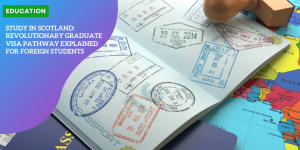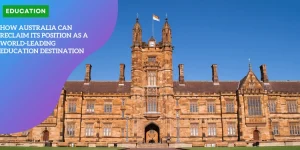Breaking: Australia Reports 25% Drop in International Student Arrivals for 2023/24
Key Statistics and Overall Decline
The latest data released by the Australian Bureau of Statistics reveals a noteworthy decline in international student arrivals for the 2023/24 academic year.
The number of student visa holders plunged by 25%, dropping from 278,000 in 2022/23 to 207,000 in this period.
This sharp decline is indicative of broader trends affecting Australia’s international education sector.
Decline in Net Overseas Migration
When looking at the bigger picture, the overall net overseas migration also took a hit.
The figure dropped from 536,000 to 446,000 year-over-year, marking a significant change.
This decline can be attributed to a combination of factors including new policies and changing global conditions.
Migrant arrivals fell by 10%, while departures increased by 8% over the same period. These changes paint a clear picture of shifting migration dynamics.
Trends and Their Implications
Breaking down these statistics helps to understand the broader migration landscape:
Migrant Arrivals and Departures: The decline in migrant arrivals and the simultaneous increase in departures suggest an underlying sentiment among temporary visa holders to return to their home countries. This is likely exacerbated by Australia’s stricter policies and post-COVID-19 adjustments.
Temporary Visa Holders: According to Jenny Dobak, head of migration statistics at ABS, the fluctuations are primarily driven by changes in the behavior of temporary visa holders. Many of them came to Australia during the rapid post-pandemic recovery phase and are now returning home as the situation normalizes.
Impact on the International Education Sector
Despite the notable decrease, international students continue to be the largest group among migrant arrivals, accounting for 39.5% of net overseas migration.
However, their contribution is the lowest it has been, excluding the pandemic-affected period, since 2016/17.
With this data at hand, it’s critical for stakeholders in the international education sector to reassess their strategies and adapt to the new requirements and global migration trends.
The figures show that higher education students still dominate the scene, making up a significant 73.9% of net student migration, while skills training students constitute only 7%.
While these statistics are telling in themselves, they also set the stage for a deeper exploration of the factors driving these trends and the subsequent responses from both policy-makers and the education industry.
The surrounding context will be crucial for understanding how to navigate and potentially reverse this decline in the coming years.
Next, we will delve deeper into the specific factors behind the observed decline in international student arrivals and migration, offering further insight into the measures and broader trends at play.
 To change the situation, one must first understand it.
To change the situation, one must first understand it.
Factors Behind the Decline
The recent drop in international student arrivals in Australia is a multi-faceted issue with several contributing factors.
Understanding these causes provides insight into why the numbers have decreased so dramatically and helps inform the sector’s response.
Implementation of Reforms
A significant factor behind the decline in international student numbers is the implementation of reforms to Australia’s international education system.
These reforms include changes designed to enhance the quality and integrity of the education sector.
The new measures ensure that only students with genuine intentions to study and sufficient resources to support themselves while in Australia are granted visas.
Stricter English-Language and Financial Requirements
The Australian government has tightened the English-language proficiency and financial requirements for international students.
These stricter criteria aim to ensure that students are well-prepared for their studies and can support themselves financially without needing to work excessively or rely on outside assistance.
The result has been a screening out of applicants who may struggle to meet these higher standards, contributing to the overall decline in student visa approvals.
Post-COVID Normalization
Another pertinent factor is the post-COVID normalization after a period of record increases in migration.
The pandemic caused significant disruptions to international travel and education, leading to a surge in student visa applications once borders reopened.
This catch-up period saw unusually high numbers of student arrivals as those who had been delayed by the pandemic rushed to commence their studies.
Now, the surge has waned, and migration levels are returning to more typical patterns, which partly explains the decline seen in 2023/24.
Summary
These factors collectively contribute to the reduction in international student arrivals. The reforms ensure that only genuine students come to Australia, while stricter requirements act as a quality check.
The normalization post-COVID represents a return to regular migration trends after a period of unprecedented movement.
Together, these elements highlight the need for a balanced and informed discussion about the future of international education in Australia, with an ongoing focus on adapting to these evolving dynamics.
Student Demographics and Contributions
Leading Group of Migrant Arrivals
Despite the recent decline in international student arrivals, students continue to make up the largest group of migrant arrivals, contributing 39.5% to net overseas migration.
This underscores the ongoing importance of international education to Australia’s migration landscape, even in the context of stricter measures and reforms aimed at improving the quality and integrity of the system.
Higher Education Students Dominate
A significant majority of these international students are enrolled in higher education programs. Specifically, higher education students account for a substantial 73.9% of net student migration.
This suggests that universities and other higher education institutions remain highly attractive to international students seeking advanced degrees and educational opportunities in Australia.
These students significantly contribute not only to the educational sector but also to the broader economy through their spending on tuition, living expenses, and other financial outlays.
Skills Training Students’ Minimal Representation
On the other hand, students enrolled in skills training programs make up just 7% of the total student migration figures.
This relatively small percentage indicates that the growth in international students is not primarily driven by this cohort, contrary to some narratives.
Instead, it highlights the critical role that higher education plays in attracting international talent to Australia.
Contributions to Migration and Economy
It’s essential to recognize that international students’ contributions extend beyond mere numbers. Their presence impacts cultural exchange, innovation, and economic activity.
They bring diverse perspectives and ideas, enriching the campus environment and fostering global connections.
The financial contributions from international students also support various sectors, including housing, retail, and tourism.
Moving Beyond Narratives
Given the data, it’s evident that higher education students are the key drivers of international student migration to Australia.
This information is crucial for shaping policies and public discourse.
The narrative that predominantly attributes the growth to skills training students is not supported by the figures.
As stakeholders and policymakers consider future strategies, it’s vital to foster a balanced view that acknowledges the diverse roles of different student cohorts.
Transition Without Explicit Preview
As we delve deeper into international student demographics, it becomes clear that continued analysis and understanding of their impact are crucial for informed policy-making and strategic planning.
This will ensure that Australia’s international education sector remains robust and adaptable in changing global contexts.
Policy Implications and Sector Response
ESOS Amendment Bill and Enrollment Caps
The ESOS (Education Services for Overseas Students) Amendment Bill has sparked significant debate in the international education sector.
This bill proposes new enrollment caps for international students, aiming to regulate the influx of overseas individuals studying in Australia.
The intent behind this move is to ensure the quality of education and prevent the misuse of student visas for work purposes.
However, many stakeholders in the education industry are concerned about the potential negative impact on the sector’s growth and contribution to the economy.
Calls for Balanced Discussion
Despite the challenging circumstances, industry leaders are advocating for a more balanced discussion regarding international education.
The CEO of the Independent Tertiary Education Council Australia (ITECA), Troy Williams, emphasizes the need to differentiate between higher education and skills training students.
According to recent data, higher education students constitute the largest proportion of international students at 73.9%, while skills training students make up only 7%.
These figures suggest that contrary to some governmental narratives, the growth in international student numbers is predominantly driven by higher education, not skills training.
Thus, it’s essential to have a nuanced conversation that acknowledges the distinct roles of various student cohorts instead of generalizing based on incomplete data.
Monitoring Visa Processing Changes
The changes in visa processing directives have introduced another layer of complexity in managing international enrollments.
The sector is currently awaiting detailed insights into how these modifications will affect future student arrivals.
Stricter English-language requirements and increased financial criteria are designed to ensure that only genuine students can enter the country.
However, these measures also carry the risk of deterring prospective students who might contribute significantly to Australia’s education landscape and economy.
Industry Response
In response to these policy shifts, educational institutions and associations are actively engaging with the government to communicate their concerns and suggestions.
They argue that a more considered approach is necessary—one that balances regulatory rigor with the need to remain an attractive destination for international students.
Continuous dialogue between policymakers and industry stakeholders is crucial to develop strategies that can adapt to the evolving educational and migratory trends.
Looking Ahead
The international education sector must navigate these changes carefully to maintain its pivotal role in Australia’s economic and cultural framework.
Despite the challenges, the focus remains on fostering a supportive environment for international students while ensuring the integrity and quality of the education system.
These dynamics will continue to be crucial as the sector evolves, demanding ongoing monitoring and adaptable strategies.







